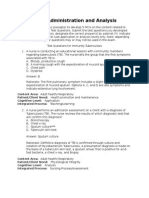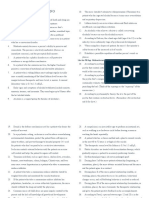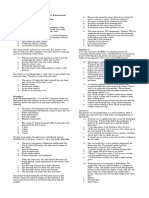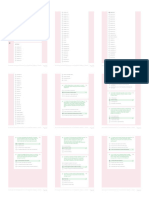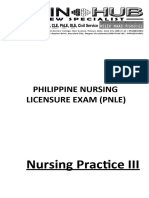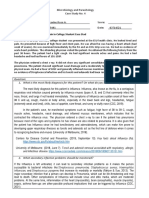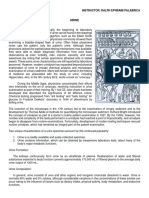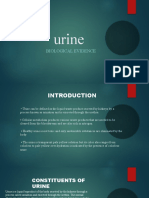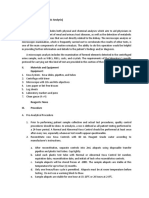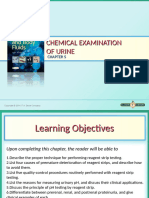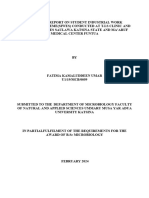Funda Compre
Uploaded by
Maxine AgasFunda Compre
Uploaded by
Maxine AgasTRA - FUNDAMENTALS OF NURSING
Mr. Beejey Wong & Dr. Aleni Iray I Comprehensive I July 20-21& July 31- Aug. 1, 2024
- ALL except for the
OUTLINE patient
I. Nursing Process
BOARD EXAM TIP:
II. Specimen Collection
(This is how data(s) were asked in the board exam)
A. Urinalysis
B. Fecalysis Identify the source and type of data
III. Pain 1. The nurse palpates edema on a client’s leg
IV. Oxygenation - Secondary source & Objective data
A. Suctioning 2. The patient complains of difficulty in swallowing
B. Tracheostomy - Primary source & Subjective data
C. Incentive Spirometry
COMMON BOARD EXAM QUESTION
D. Chest Drainage
Ideal position in performing abdominal assessment
E. Chest Physiotherapy
V. Sleep and Sleep Disorders ● Dorsal Recumbent
A. Sleep Cycle ● NOT SUPINE since mas nakakarelax ang dorsal
B. Insomnia recumbent
C. Sleep Apnea ASSESSMENT OF ABDOMEN
D. Hypersomnia
In assessing abdomen, the sequence is:
E. Narcolepsy
● RLQ > RUQ > LUQ > LLQ
F. Parasomnias
If the patient has cholecystitis
VI. Nursing
VII. History of Nursing ● The pain is in RUQ - so this would be the last
VIII. Role of Nurses quadrant to be examined.
IX. Nursing Theorists If the patient has appendicitis
● RLQ - last quadrant to be examined
Pancreatitis
NURSING PROCESS
● LUQ - last quadrant to be examined
NURSING PROCESS BOWEL SOUNDS
● Normal: 5-30 per minute
● Lydia Hall - started the nursing process in 1955 ● Below 5 - hypoactive bowel sounds
● More than 30 - hyperactive bowel sounds
● No sounds in 5 minutes - absent bowel sounds
NURSING PROCESS
Diagnosis Nurse’s Role
Assessment Collection of data
● Interpretation/analysis of
TYPES OF DATA:
data
● Subjective Data - symptom
TYPES OF NURSING DIAGNOSIS
- described by the
● Actual
patient
- with problem
- e.g., tinnitus,
- the problem is
vertigo, pain
already present
● Objective Data - sign
- priority
- can be measured/
- e.g., ineffective
observed
airway clearance
- e.g., edema
● Risk
SOURCES OF DATA:
- problem is not yet
● Primary Source - patient
present pero
● Secondary Source -
malapit na
significant others, chart, lab
- e.g., risk for injury
results
● Possible/Potential - no
problem
TRANSCRIBED BY: DAISY 1
COMPREHENSIVE I FUNDAMENTALS OF NURSING
- etiology of the ● Independent - initiated by
problem is the nurse
unknown/ - e.g., the nurse turns
uncleared the patient every 2
● Syndrome - cluster/group hours
of symptoms ● Dependent - based on
- more than 1 physician’s order
symptom is - carried out a
presented doctor’s order
● Wellness - patient is ready - pharmacologic
for discharge/rehabilitation action
- e.g, readiness for - e.g., nurse
administer
BOARD EXAM TIPS antibiotic based on
● Activity intolerance and risk for injury - priority is doctor’s order
activity intolerance (both are safety) - e.g, nurse
● Always prioritize the actual - since the problem administer
is already there paracetamol
SAMPLE QUESTIONS ● Interdependent -
● A patient with esophageal cancer is admitted to collaboration
the hospital with a complaint of fever, fatigue, - the nurse consults
dysphagia, and weight loss. What is your priority the dietitian for
nursing diagnosis? patient’s food
- Altered Nutrition
SAMPLE QUESTION
TEST-TAKING STRATEGY What is your priority after the post-barium enema?
● Encourage ambulation - since pwedeng gawin
In looking for a nursing diagnosis
ni nurse alone; pwede ang laxative but it needs
1. Make sure that it is related
doctor’s order
2. Choose actual nursing diagnosis ● Always choose the independent intervention
3. Maslow’s Hierarchy of Needs ● Barium enema - part of LGIS which uses barium
sulfate > SE: constipation > encourage
ambulation
Planning Goal setting place
● Normal SE after barium enema: white stool
Types of Goal
within 48 hrs
● Short-Term Goal - within a UPDATE
week (1 week) ● Assess for iodine allergy, not SHELLFISH - walang
● Long-Term Goal - more connect ang shellfish allergy sa iodine
than a week TEST TAKING STRATEGY
When to answer pharmacology?
● Kapag lahat ng choices ay gamot or kapag ang
TEST-TAKING STRATEGY
question ay pharmacologic intervention.
If the duration is not stated
● Kapag may isa or dalawang gamot sa choices -
● After surgery the patient is able to cook his own
most likely mali
meal
● Long-term
● if home or work is stated - long term Evaluation ● Response of the patient to
● After surgery the patient is now able to the nursing process
ambulate in the hallway ● Modification is done
● short-term TYPES
● the patient is still in the hospital ● Goals are met - discontinue
the nursing process
Implementation Actions ● Goals are partially met -
TYPES OF INTERVENTION: reassess, continue, modify
TRANSCRIBED BY: DAISY 2
COMPREHENSIVE I FUNDAMENTALS OF NURSING
● Goals are not met - ● Confirmatory test for
reassess, continue, modify infection
● Use clean gloves
TWO METHODS
SPECIMEN COLLECTION ● Clean-Catch/ Midstream -
clean > void > catch > void >
Specimen Collection clean
- Clean the meatus
● Best time to take specimen - early morning > 6 am
using water first
in the morning
(antiseptic and
● Prepare
feminine wash can
- Sterile container
alter result)
- Clean gloves
- Do not collect the
first flow - usually
URINALYSIS contaminated
- Collect the
midstream
TYPES
- Clean after
collection
Routine ● Minimum amount - at least
● Catheterized Urine - collect
Urinalysis 10 cc
from the catheter
(UA/Random) ● Check for color, pH, and
specific gravity
● Normal color - straw/amber
● Normal pH - 4.5 -8.0
(maintain slightly acidic - to
prevent UTI)
● Normal Specific Gravity -
(measures the concertation
of the urine) 1.010 - 1.025 -
30
- SIADH - high
A. Bag - bawal
- DI - low
magcollect since
● ABN: traces of blood,
contaminated
CHON/Albumin,
B. Tubing - dito
glucose/ketones,
nagcocollect,
pus/crystals
self-sealing so
hindi magleleak;
NURSING RESPONSIBILITIES FOR UTI medj slunt ang
● Acid Ash Diet - to maintain acidic (CPP) pagpuncture
e.g., cranberry plum C. Port - connected
● Increase fluid intake to the balloon that
● Anterior to posterior wipe anchors the
● Wear cotton underwear catheter to the
● Avoid silk, nylon - not absorbent/ breathable bladder - hindi
● Avoid tub bath, jacuzzi, swimming - anything nagcocollect since
that is water soaked - shower is recommended baka madeflect
● Void immediately after coitus yung balloon
STEPS IN COLLECTING URINE IN
Urine Culture ● Checks for specific CATHETER (3Cs)
and Sensitivity pathogen and medication
to be used
TRANSCRIBED BY: DAISY 3
COMPREHENSIVE I FUNDAMENTALS OF NURSING
1. Clamp - for at least 30 mins kakaiba (wag
to 1hr para makaipon ng ihi yung foreign
2. Clean - wipe with alcohol or object)
cotton and let it dry - kapag walang
3. Collect - using a sterile dugo hapain ang
syringe part na may
Luer Lock Catheter mucus
- if flawless ang
stool - collect sa
middle or collect
on two
portions/side of
the stool
● has 2 ports - 1 for the bag - Collect 1 inch or 1
and 1 for the collection tsp
● no need for needle - - If diarrhea -
needleless so syringe na collect 10-20 cc >
lang directly na sa
● same procedure (3Cs) anus
HOW LONG TO BE SUBMITTED?
● Stool should be fresh and
Timed Collection 24 HR Urine Collection
warm
● used for schillings test, VMA,
● Should be within 1 hr
creatinine clearance
● If may nakalimutan/skip -
restart Stool Culture and
Sensitivity
● Can be delegated to
nursing aid - if
Fat Analysis ● Checks for the fat in the
magcocollect lang
stool (steatorrhea) - to
● Para mamaintain ang
detect hepatobiliary
quality ng urine - lagay sa
disorders
ref or nagaadd ng
PREPARATION
preservatives sa container
● 3 days before - advice to
para di na ilagay sa ref
have high-fat diet > to
e.g., July 20
analyze kung kaya tunawin
● 8 AM 1st void - discard all
ang fatty food
● 10 Am 2nd void - collect
● Time collection - can be 24
● Ends on July 21 at 8 AM -
hr, 36 hr, 48 hr or 72 hr
last voiding - collect (last)
● Refrigerate
FECALYSIS Fecal Occult ● To detect GI bleeding
Blood Test / ● Occult - hidden or
Guiac Test microscopic (not seen in
TYPES the naked eye)
PREPARATION
Routine WHERE TO COLLECT? ● False Positive
Fecalysis ● Toilet bowl - should be in - avoid
clean surface dark-colored food
● Best part of stool (solid) e.g., red meat,
- find the part na chocolates, beef,
dinudugo or raisins for at least
TRANSCRIBED BY: DAISY 4
COMPREHENSIVE I FUNDAMENTALS OF NURSING
● 2-3 servings of meat
3 days prior to ● 2-4 servings of fruits
specimen ● 3-5 servings of vegetables
collection ● 6-11 servings of CHO
- Avoid Iron, NSAIDs, ● Servings - kasing laki ng posporo
and Corticosteroid ● In elderly - almost the same food pyramid but with
(ORAL) - stop 7 8 glasses of water and supplements (calcium and
days prior to iron)
specimen
collection (NSAIDs
and Corticosteroid
are GI irritant
● False Negative
- Vitamin C - 250
mg
(for elderly)
For Geriatrics, food pyramid is almost the same
● Supplements: calcium and iron (especially
RESULT women)
● Green/Blue - positive ● S: fats/oil/sweets
● No color change - negative ● 2-3 servings of milk
● 2-3 servings of meat
Fecal Immunochemical Test (FIT)
● 2-4 servings of fruits
- a newer/updated version of
● 3-5 servings of vegetables
FOBT
● 6-11 servings of CHO
- same as FOBT but no
● 8 glasses of water
restrictions
- can be performed anytime
or immediately Calories Male
- not always available
● 2,500 cal/day
Female
BB GURL TIPS !1!
● 2,200 cal/day
If Addison’s Disease
COMPUTATION OF CALORIES
- DOC: Steroids
- Hindi magsstop for 7 days kasi magaadisonian (If no label)
crisis ● CHO - 1g x 4 cal
- Instead change the route of the medication ● CHON - 1g x 4 cal
para di maalter ang stool ● Fat - 1g x 9 cal
e.g., 60g of CHO, 40g CHON, and 35g
● CHO = 240g
NUTRITION ● CHON = 160g
FOOD PYRAMID ● Fat = 315g
● Total: 715g
FOOD PYRAMID
COMMON BOARD EXAM QUESTION
In females add calories in case of
● Pregnancy - add 300 calories
● Lactating - add 500 calories
If both pregnant and lactating - add 500
NASOGASTRIC TUBE (NGT)
NGT
● S: fats/oil/sweets
● 2-3 servings of milk
TRANSCRIBED BY: DAISY 5
COMPREHENSIVE I FUNDAMENTALS OF NURSING
Purpose ● Gavage - feeding ● Instruct the patient to hold
● Lavage breath while removing the NGT
● Decompression
● To administer medication NURSING RESPONSIBILITY
Preparation ● In inserting NGT - use clean Placement ● Check every before feeding
gloves
- Clean technique WAYS TO CHECK THE PLACEMENT
- since this is GI ● X-ray (abdominal)-
procedure confirmatory
- GI is not sterile - only in initial and
● Measurement - NEX confirm
- tip of the nose, to the - not realistic
earlobe, to the - done only once right
xiphoid process after insertion
● Aspiration - aspirate the
2 Types of ● Rubber - malambot > mas gastric content and check the
Tubings of mahirap ipasok > papatigasin pH
NGT > submerge to ice/cold water - best way to check the
or lagay sa ref before ipasok placement
● Plastic - matigas > lubricate - N: less than 4 (0-4) -
using KY jelly > para dumulas very acidic
- Aspiration can also
Insertion ● Position - High Fowler’s, sitting, check the residual
upright volume
● Head - hyperextend and lean - Normal Residual
forward Volume - < 100 ml
- una muna (depende sa previous
hyperextend (if feeding)
before insertion) ● Auscultation - listen for
- then flex/lean forward guarding sound
the head if there’s
resistance or kapag Patency ● To check the patency - flush
dumaan na sa using asepto syringe (water -
nasopharnyx (during distilled)
insertion) ● Usually 30-60 ml
● Instruct the patient to swallow ● Every before and after feeding
- kapag kaya lang
- swallowing para di
TOTAL PARENTERAL NUTRITION
maligaw sa trachea
TPN
Feeding ● Position
- During feeding - ● Complete nutrition
semi-fowlers ● Includes: glucose, chon, lipids, amino acids, vit and
- After feeding - minerals and trace elements
semi-fowler or ● Parenteral
upright for at least - outside the GI (IV, IM, SubQ)
30mins or up - Uses larger vein: subclavian vein (located
below the clavicle)
● Uses sterile/aseptic technique
Removal ● Position - Semi-fowlers
● Feeding position: Semi-fowlers
TRANSCRIBED BY: DAISY 6
COMPREHENSIVE I FUNDAMENTALS OF NURSING
Insertion ● Best positioning Underweight ● Below 19
- trendelenburg/
supine w/head
Normal ● 19-24.9
lower
● Goal is mapuno ng blood
yung upper body para Overweight ● 25-29.9
maprevent ang pulmonary
embolism kasi puno ng
Obese ● 30 and above
dugo sa vein
Removal ● Best positioning
PAIN
- trendelenburg/
supine w/head
lower PAIN
● 5th vital sign
Complications 1. Hyperglycemia - happens ● Subjective data
when the TPN is infused ● Unpleasant experience
rapidly
- MNGT: Regular
TYPES OF PAIN
Insulin
2. Hypoglycemia - happens
Cutaneous Pain ● Originates in the skin
when the TPN is abruptly
● e.g., burns, pressure ulcers,
stopped.
abrasions
- To stop the TPN -
wean/taper off
Somatic Pain ● Originates in the muscles/
- MNGT: Dextrose in
joints
10% solution
● E.g., cramps, arthritis
3. Infections/Sepsis
DEEP SOMATIC PAIN
- site + glucose
● Includes bones
- Maintain aseptic
● e..g, fractures
technique
- Most common
complication Visceral Pain ● Originates in the organs
(internal)
● E.g., pain in the LUQ >
BODY MASS INDEX pancreas
BMI Phantom Pain ● Pain at the site that is
already missing/gone
● Formula:
● Common after amputation
- Weight (kg) / Height (m)2
e.g., 6 feet and 180 lbs MNGT
- 180 lbs/ 2.2 = 81.8 kg ● Give pain medication - pain
- 6 feet > inches > centimeter > meter is subjective data
- 6 feet x 12 = 72 inches > 72 x 2.54 = 182.88 - all pain is real
cm > 182.88/100 = 1.83 m
● Mirror Therapy - sit on the
- 81.8/3.35 = 24.4 kg/ m2
floor with a mirror between
e.g., 5’6 feet and 160 lbs
- 5 x 12 = 60 + 6 = 66 in the legs > to relieve the pain
- 66 x 2.54 = 167.64 cm by tricking the brain
- 167.64/100 = 1.68m
- 160/2.2 = 72.7 kg
- 72.7/1.68(2) = 72.7/2.82 = 25.8 kg/m2
INTERPRETATION OF BMI
TRANSCRIBED BY: DAISY 7
COMPREHENSIVE I FUNDAMENTALS OF NURSING
- e.g., DU pain is 2-3
hrs after meal > DU >
revokes is empty
stomach > relieve by
food intake
● Quality
- Patient’s own
description of pain
- Never choose
PHANTOM SENSATION
close-ended
- e.g after mastectomy >
question
feeling mo may boobs ka pa
(answerable by yes
pero wala na but doesn’t
or no)
include pain
- Avoid suggesting
question e..g., is your
Intractable Pain ● Pain without relief
pain sharp or
● e..g., perfurated ulcer -
burning?
forever na ang pain
● Region/Radiation
- Location of the pain
Psychogenic ● Pain without physiologic - Best tool: finger
Pain basis ● Severity
- Painscale (numeric)
Referred Pain ● Pain is perceived on the - Wong - Baker’s Scale
other side - if a number is not
● mas mahirap i-diagnose applicable; uses 6
● e..g, cholecystitis - pain in facial expression
RuQ > pain in the shoulder
Radiating Pain ● Mararamdaman ang origin
ng pain
● e..g., cholecystitis - the pain
● Time
is extended to a specific part
- onset/duration/
intervals
- acute/chronic
PAIN ASSESSMENT
PAIN SCALE INTERPRETATION
PQRST 1st Step in Pain Assessment -
Acceptance (Accept that the patient is
TWO WAYS
in pain)
● Provoked/Precipitating ● 0 - no pain ● 0 = pain
Factor ● 1-2 = mild ● 1-3 = mild pain
- reflects the patient’s ● 3-4 = moderate ● 4-6 = moderate
● 5-6 = severe ● 7-10 = severe
last activity before
● 7-8 = very
pain
severe
- e..g, GU - pain is 30
● 9-10 = worst
mins post-meal >
what provokes pain
EXAMPLES
is meal intake/food >
● e.g., pain of 7 out 10
to relieve pain > - very severe pain
vomits ● e.g., pain of 5 out 10
- moderate pain
TRANSCRIBED BY: DAISY 8
COMPREHENSIVE I FUNDAMENTALS OF NURSING
● e.g., pain of 3 out 10 ● NSAIDs - e.g., ibuprofen -
- moderate pain pwede for pain, fever, pwede
● e..g, pain of 5 out of 10 for inflammation
- severe pain
● Are they the same? - NO!
(depende sa choices ang sagot)
Both are antipyretic and
analgesic but NSAID is
anti-inflammatory.
PAIN MANAGEMENT (PHARMACOLOGIC)
SIDE EFFECTS
● Gi Irritation - common
Opioids ● Also known as narcotics
complaint is heartburn > take
● CNS Depressant
with meals to minimize the GI
● e..g, morphine, meperidine
irritation
(demerol), oxycodone,
fentanyl
Co-analgesic ● formerly known as adjuvant
● Morphine and meperidine are
medication
commonly asked in
● Any drugs that can help with
Hepatobiliary Pain e.g.,
pain management
pancreatitis, cholecystitis
● e..g., diazepam - anxiolytics >
● Pancreatitis - use morphine;
but can still relieve pain since
demerol can cause seizure
muscle relaxant/sedative
SIDE EFFECTS
● e.g., benadryl - antihistamine
● Drowsiness / Altered LOC-
> can relieve pain thru its
side effect that is mostly
sedative effect
monitored > monitored for
adverse effect = respiratory
depression > always check the OXYGENATION
patient’s RR
SUCTIONING
● Nausea
● Urinary Retention SUCTIONING
● Constipation - universal/most
common side effect ● To remove secretions and maintain patent airway
● Use sterile gloves (technique) - since respiratory
● Pruritus - most common side
● Both hands are sterile both the dominant hand
effect in elderly
should stay sterile while the latter can be unsterile.
ANTIDOTE ● Requires PPE - complete PPE
● Naloxone (Narcan) - an INDICATION
antidote for opioid toxicity ● Dyspnea - difficulty of breathing
● Drooling
● Decreased breath sounds
Can opioid lead to addiction?
● Decreased 02 saturation
● NO! - it rarely happens
● But this can inc. drug tolerance - need to
increase the dosage to have an effect COMPLICATION OF SUCTIONING
Hypoxia ● due to prolong suctioning
SIDE EFFECT AND ADVERSE EFFECT
● oxygen is also suction
● Side effect - normal effect of the drug
TO PREVENT:
● Adverse effect - toxic effect of the drug
● Hyperoxygenate prior
suctioning - e.g., the patient
Non-opioids/ ● Non-opiods - e.g.,
has bag valve mask (BVM) >
NSAIDs acetaminophen (tylenol) -
give 3 hyperinflation > 3 dose
pwede for pain, fever, bawal
before oxygenation > for 1
for inflammation
minute
TRANSCRIBED BY: DAISY 9
COMPREHENSIVE I FUNDAMENTALS OF NURSING
● e..g, 02 tank > adjust to 10-15 ● Can be extended to 15
lpm for 1 min before suction seconds if necessary
● Mechanical Ventilator can
also be used to Interval ● Rest in between suction
hyperoxygenate. ● 20-30 seconds
Bleeding/ TO PREVENT Total Time ● Should not exceed to 5
Trauma ● Do not apply suction during minutes
insertion of catheter - apply
during withdrawal instead
ET/TT
TYPES OF SUCTIONING
Position ● Conscious: SF
● Unconscious:
OROPHARYNGEAL Side-lying/lateral position
facing the nurse
Position ● Conscious: SF
● Unconscious: Length ● No length until you meet the
Side-lying/lateral position point of resistance
facing the nurse ● insert > resistance > withdraw
● Head of the patient is on the 1 inch > suction
side to promote drainage of
secretion Duration ● 5-10 secs
● Cannot be extended since
Length ● Nose - earlobe this is an artificial airway -
● 4-6 inches (10-15 cm) cannot prolong the suction >
risk for hypoxia
Duration ● 5-10 secs
● Can be extended to 15 Interval ● Rest in between suction
seconds if necessary ● 2-3 minutes - since this is an
artificial airway
Interval ● Rest in between suction
● 20-30 seconds Total Time ● Should not exceed to 5
minutes
Total Time ● Should not exceed to 5
minutes
TYPES OF SUCTION MACHINE
PORTABLE WALL MOUNTED
NASOPHARYNGEAL
Position ● Conscious: SF Infant 2-5 mmHg 50-95 mmHg
● Unconscious:
Side-lying/lateral position Child 5-10 mmHg 95-110 mmHg
facing the nurse
● Head should be hyperextend Adult 10-15 mmHg 100-120 mmHg
Length ● Nose - earlobe
● 4-6 inches (10-15 cm) TRACHEOSTOMY
TRACHEOSTOMY
Duration ● 5-10 secs
TRANSCRIBED BY: DAISY 10
COMPREHENSIVE I FUNDAMENTALS OF NURSING
● Artificial airway
● Tracheostomy and ET Tube - ET Tube iniinsert lang - rinse in NSS
and first choice while tracheostomy is a surgical - how long is
procedure and should be done only if long term. depending on the
secretions
3. Dry
INSERTION
- never use gauze d/t
its lint na pwedeng
● Insert outer cannula and obturator > remove the
obturator > insert the inner cannula > lock the dumikit sa cannula
inner cannula > in a clockwise direction > to - tap or shake it to dry
unlock - counterclockwise
● Some institution have a disposable inner
PARTS OF TRACHEOSTOMY cannula hence di na need gawin ang 3 steps
Inner Cannula ● Lock - clockwise Tracheostomy ● Need to change
● Unlock - counter clockwise Ties ● “Father Don’t Wait”
● Tie, Tie, Knot, Knot, Untie, Untie
Outer ● Tie, Tie, Knot, Knot - the new
Cannula ties before you Untie, Untie the
old ties
Obturator ● Guide for insertion ● Make sure that the tie is not
● Should be available at the too tight or too loose before
bedside you knot
- to ensure the
T. Ties ● To secure the outer cannula to tightness or
prevent dislodge looseness - insert 1-2
fingers (but in case
T. Cuff ● A balloon - iniinflate every of specific answer - 1
time the patient is eating finger)
● To provide an air tight seal to ● Use square knot
the trachea to prevent
aspiration and to prevent Equipment ● Obturator
leakage of air. available at ● Sterile forcep
the Bedside ● Suction
● Most of the tracheostomy is
cuffless ● Tracheostomy set
● Magic slate - means of
communication of the patient
NURSING RESPONSIBILITY (TRACHEOSTOMY CARE)
Inner Cannula ● Perform tracheostomy care in EMERGENCY SITUATION IN TRACHEOSTOMY
inner cannula every shift
● Use sterile technique Dislodge of ● The first thing to do is retract
3 STEPS Outer the stoma (to make sure that
Cannula the patient still have an
1. Soak
- soak in hydrogen airway) then notify the
peroxide physician
(Half-strength) - ● To retract the stoma - ibubuka
diluted using sterile clamp/forcep
- 50% hydrogen
peroxide and 50%
INCENTIVE SPIROMETER
sterile water
2. Rinse
INCENTIVE SPIROMETER
TRANSCRIBED BY: DAISY 11
COMPREHENSIVE I FUNDAMENTALS OF NURSING
● Main purpose is to have lung reexpansion - to
maintain negative pressure in the lungs
● Position: SF with arm raised
● Usually uses fr 12-14
INDICATION
● Pneumothorax
● Hemothorax
● Pleural Effusion
● Other name: Sustained Maximum Inspiration Device UNDERWATER
(SMID)
● To promote lung expansion and to prevent ● Observe for air bubbles/bubbling
atelectasis
● Commonly used by post-op patient
Drainage ● Connected to the patient
- possible sumakit ang site ng post-op
● No intermittent bubbling
patient
● Measures inspiratory volume (lung capacity) ● Always check for the level,
● Position: Upright/ Sitting/ HF amount, and characteristic of
the drainage.
● Normal drainage: not above
BEFORE INCENTIVE SPIROMETER
100 cc
● Add the drainage to the
Splinting
output of the patient
Pain Meds ● To decrease the pain
Water Seal ● (+) Intermittent Bubbling -
non-continuous bubbles
● Air leakage - continuous
STEPS IN USING INCENTIVE SPIROMETER bubbling > find the source of
leak
1. Exhale fully, seal the lips into the mouthpiece
2. Inhale slowly, level the eyes at the goal marker Suction ● Connected to the suction
then hold breath (2-6 seconds) machine
3. Exhale normally ● Suction machine is turned on:
continuous bubbling
● Suction machine is turned off:
SCHEDULE no bubbling
Best Time ● Before meals or before
PROBLEMS (MINOR)
bedtime
Blood clots in ● Normal in hemothorax
Perform ● 4-5x day and 10 times each
tubing ● But can cause obstruction to
session
the tubing
BOARD EXAM QUESTION
NURSING RESPONSIBILITY (POST) ● Intervention - gently squeeze
or pinch the tube
● Deep breathing exercise
● Oral care ONLY 2 SITUATIONS WHERE CLAMPING THE TUBE IS NEEDED
● Clean or wash the mouthpiece 1. Checking the source of air leak
2. If papalitan ang system - change system
Clamping should be very quick less than 15 seconds > if
more than > tension pneumothorax
CHEST DRAINAGE
TWO COMMON PROBLEMS
CHEST DRAINAGE/CHEST TUBE
TRANSCRIBED BY: DAISY 12
COMPREHENSIVE I FUNDAMENTALS OF NURSING
Disconnect ● Natanggal sa system > ● Pattern - only apply vibration
submerge/soak in the basin when the client exhales
with NSS to create the ● Duration - should not exceed
temporary seal. 5 minutes
● Nabasag ang bote kaya
natanggal Postural ● A technique in which different
Drainage positions are assumed to
Dislodge ● Natanggal sa patient > cover facilitate the drainage of
with sterile dry and secretions from the bronchial
non-occlusive dressing > tape airways.
the 3 side to prevent tension ● Using the principle of gravity
pneumothorax ● Location is based on the
Occlusive - cover the opening affected portion of the lungs
completely; used only if the chest tube or where the secretion is
is to be removed located
● Duration - 10-15 minutes
● e.g., secretion in the left lung >
REMOVAL position the patient right side
lying > always elevate the
● To determine if the chest tube is ready to affected side (left)
remove - Chest X-ray ● e.g., both sides of the lungs
● Semi-fowlers position has secretion - alternate
● Bear down and hold breath / valsava manuever
● e.g.. both side of the apex of
● Use occlussive dressing
the lungs - position in upright/
HF
● e.g., congestion in the left
CHEST PHYSIOTHERAPY
posterior > right sims lateral
● e..g, base on the lungs >
CPT
Trendelenburg > pero if di
● Percussion, vibration, postural drainage kaya ng patient use pillows to
● Before meals/bedtime elevate
● Should not exceed 30 minutes
Percussion ● To dislodge the secretion SLEEP
using cupped hands
● Direction is going up - only SLEEP
one direction
● Physiologic need
● Duration - should not exceed ● It is a universal biologic process common to all
5 minutes people
● Avoid percussion on the bare ● Altered state of consciousness
skin - dapat may cover such ● ⅓ of life - 7-9 hours of sleep per day
● Biologic Rhythms - Circadian Rhythms (about a
as damit, towel kasi
day)
mamumula
● Avoid percussing on the bony
prominence TYPES OF SLEEP
Vibration ● To loosen or mobilize the NREM ● Non-rapid eye movement
secretion using the palm or ● 75-80% of sleep is NREM
heel of the hand ● Has 3 stages
● Direction is going down
TRANSCRIBED BY: DAISY 13
COMPREHENSIVE I FUNDAMENTALS OF NURSING
SLEEP DISORDERS
3 STAGES OF NREM
INSOMNIA
NREM I (DEAD) NREM II (DIE) NREM III (D) INSOMNIA
VLS - very light LS - light sleep DS - delta/deep ● Difficulty in falling/maintaining sleep
sleep - usually sleep ● Mabilis makatulog > then mabilis din magigising
(hindi pa last for - seen in RISK FACTORS
nakapikit pero 10-15 EEG > ● Aging - higher > mas risk
naantok na) mins puro ● Female - mas madaming iniisip
- last for delta ● Stimulants - food, caffeinated, medications
a few Hallmark - - e.g., levothyroxine - taken in the morning
mins snoring since can cause insomnia
(hindi normal - If the medication is taken in the morning
ang magssnore most likely the S/E is insomnia
kagad kapag ● Stress - financial
sleep)
D - drowsy and D - dec. HR, RR, D - difficult to MANAGEMENT
relaxed and body temp awaken
E - eyes (will roll I - inc. stimulus D - diminish Sleep Diary/ ● Document the time, and
from side to to be awakened reflexes Log duration of the sleep
side) E- eyes still D - dec. HR, RR,
● Important for diagnoses
A - awaken temp (lowest)
easily (unting
stimulus lang Bedtime ● Hayaan ang patient gawin
magigising Rituals
kagad)
D - dec HR and Warm Bath ● For relaxation
RR (slightly)
Warm Milk ● Has L-tryptophan that
promotes sleep
REM ● Rapid eye movement
● Happens once every 90
Avoid ● The food might be a stimulant
minutes bedtime
● In 8 hrs of sleep REM happens snack
5-6 times
● inc. Acetylcholine and Avoid ● Disrupts sleep cycle
Dopamine > which translates daytime nap
to - dreams (hallmark of REM)
● Irregular vital signs - kasi Exercise ● Should be in AM or afternoon
nananaginip > vital signs ● Do not do before sleeping -
depends on the dream can alter sleep cycle
● Inc. GI secretion - naglalaway
kapag nananaginip Avoid ● Caffeinated beverages
stimulants
SLEEP CYCLE Environment ● Depends on the preference of
the patient
SLEEP CYCLE
● Happens 5-6x in 8 hours of sleep ● Medications can lead to dependency
SEQUENCE
● NREM 1 & II for 20-30 minutes > NREM III for 20-30
minutes > NREM 2 for 20-30 minutes > 1ST REM for SLEEP APNEA
10-15 minutes
SLEEP APNEA
TRANSCRIBED BY: DAISY 14
COMPREHENSIVE I FUNDAMENTALS OF NURSING
● Apnea - cessation of breathing
● Hindi mo malalaman na nagssleep apnea ka Bruxism ● Clenching of the teeth
kapag ikaw lang mag-isa- ibang tao ang ● No definite management
makakaalam except in some severe
● Hallmark - loud snoring cases > use mouth guard/
● 5x stop of breathing for at least 10 secs per hour mouthpiece
Enuresis ● Bed wetting
TYPES OF SLEEP APNEA ● MNGT: empty bladder
going to bed, use diaper,
Obstructive CAUSE (obstruction) dec.OFI
(OSA) ● Nasal polyps
● Enlarged tonsils PLMD (Periodic ● involuntary movement of
● Obesity Limb Movement the limb while sleeping
Disorder) - only in sleep
Central ● There’s something wrong with
RLS (Restless Leg ● involuntary movement of
CNS
Syndrome) the limb while sleeping
● sleep and awake
MANAGEMENT
Somnambulism ● Sleep walking
● Priority: Safety
Depending on ● Nasal polyps - surgery
the cause ● Obesity - weight loss Somniloquy ● Sleep talking
CPAP ● Continuous Positive Airway
NURSING
Pressure
● CPAP Mask
NURSING
● Keeps the airway open
● NUTRIX - a latin word which means to nourish
● An art and a science
HYPERSOMNIA ● Nursing is caring/ compassion - mas importante
ang compassion (true concern)
HYPERSOMNIA ● Committed to promoting individual, family,
community, and national health goals in the
● Excessive daytime sleepiness manner.
● Metabolic disorders - DM /Hypothyroidism BEQ: If you take care of an individual who will benefit from
it?: - NATION (Umbrella effect) from individual > family >
NARCOLEPSY community > nation
● Committed to personalized or individualized care
NARCOLEPSY services for all persons without regards to color,
creed, or social or economic status
● Sleep attack - (BEQ) Islam - not included in food tray
● Dx: Lumbar puncture who practices islam? - pork or pork with
● D/t dec. hypocrite (orexin) alcohol beverages , shellfish (crabs,
● Priority: safety shrimp) - .e..g., CDO na may halal seal
pero may pork sa company. e.g., sa saudi
PARASOMNIAS bawal sa alimango (mud crab -pwede
kasi nasa lupa) and alimasag (blue/true
crab -bawal)
PARASOMNIAS
- Halal - allowed to eat - e.g., sea products
● Other sleep disorders that cannot identify the cause - Haram - forbidden - e.g., land products
pwede ang chicken and beef kasi tama
ang process
CLASSIFICATION OF PARASOMNIAS
(BEQ) Why nursing is an art?
● Any of these is considered as parasomnias
TRANSCRIBED BY: DAISY 15
COMPREHENSIVE I FUNDAMENTALS OF NURSING
1. Therapeutic use of self - burn - uses wet to dry dressing
● Sits, stays, self (offering), silence e.g., salem sump tube
● Reflects emotions and patient tells (emotional - looks like ngt but drains air or fluid that is
catharsis > vent out emotions) connected to suction
● Wrong answer - “nurse tells.” which is a - (BEQ) prevents abdominal distention
command
Avoid ● Asking “why?” - magiging (BEQ) Why nursing is a science?
defensive si patient sa
emotions nya and
● Profession with a specific/ specialized body of
mageexplain pa sya, every
knowledge
feelings is valid, we should
recognize the feelings
● “It’s okay” - false reassurance HISTORY OF NURSING IN THE PHILIPPINES
● “That’s nothing” - belittles the
patient
HISTORY OF NURSING
● Giving advice - we only provide
options, e.g., never advice PHILIPPINE REVOLUTION
family planning method since A. Dona Hilaria de Aguinaldo - founder of Philipine Red
this is an objective Cross
B. Trinidad Tecson - Mother of Ph. Red Cross
2. Art because nursing is a profession that requires
dexterity of skills - e.g., retdem HOSPITALS AND SCHOOLS OF NURSING
- skill based (TRIAD OF NURSING HOSPITAL - IMH, PGH, ST. Paul)
THREE SKILLS RQUIRED TO A NURSE 1. Iloilo Mission Hospital School of Nursing (iloilo City,
1. Communication skills - e.g., charting is a type of 1906)
communition such as ADPIE - first school
- nursing diagnosis - ABC then problem, - currently Central Philippine University
etiology(r/t), s/sx (AEB,AMB) - Introduced by American Baptists
- e.g., self-esteem disturbances r/t 2. Philipine General Hospital School of Nursing (Manila,
rejection by the husband aeb crying or 1907)
isolation 3. St. Paul’s School of Nursing (Manila, 1907)
- in paper chart, after giving medication
sign with a ballpen (permanent ink) COLLEGE OF NURSING IN THE PHILIPPINES
(BEQ) EMR - Electronic Medical Record - a form of 1. University of Santo Tomas College of Nursing (1946)
communication which is more convenient - first college
- (BEQ) Disadvantage: breech of confidentiality - formal education
kapag nakalimutan isara/log-out. 2. Manila Central University College of Nursing (1947)
- How to guarantee to avoid breech of
conifentiality - use of password
(BEQ) What’s makes suidical fatal?
2. Hands on/ manual skill
- knows the procedure
3. Cognitive skills ● Plan - if there’s a plan
- measured thru board exam ● If there’s suicidal - “How do you plan to kill
- decision-making skills yourself?”
DECISION-MAKING SKILLS EXAMPLE
e.g., Myocardial Infarction Cues of Suicide
MS - MONA
Funda 1. Actual or imagined loss
1. call for help 2. Giving away of possesion
2. take note of the time - to know kung ilang 3. Tying of loose ends - nakikipagbati sa kaaway
minutes nawalan ng oxgen si patient
e.g., eviceration - cover with sterile gauze moistened with
NSS
Activity for Depressed Patients
e.g., dressing
1. dry - for protection
2. wet - removes dead skin cells and debris,
TRANSCRIBED BY: DAISY 16
COMPREHENSIVE I FUNDAMENTALS OF NURSING
Defense mechanism of depreessed: introjection - sinisisi First ● RA 877
nila ang sarili nila Philippine - 1953 > Republic Act >
1. Minute Actiity Nursing Law law created by the
- simple, easily accomplished since
people
mababa ang self-esteem nila
- e.g., folding of clothes > compliment
- e.g., taking a bath All laws created before 1935 - are called Act
- e.g., drawing > free form in a blank All laws created after 1935 - are called RA
paper 1935 - establishment of the Philippine Congress
Activity for Manic Which case can be filed?
●Gross manual Criminal Case ● violated Republic Act E.G., RA
●Uses energy but non-competitive - 9173
nakakapagod na activity and ayaw nila ● against the People of the
naatatalo
Philippines
● e.g., Gardening
Liability (Parusa)
● e.g., walking
1. Criminal - imprisonment
Snacks for manic - finger food na kumpleto sa cho, chon,
fats 2. Civil - pay a fine
● e.g,, cheeseburger, siopao
● bawal ang fries Civil ● against private person
● Penalty: pay a fine
● e.g., patient and nurse
NURSING LEADERS IN THE PHILIPPINES
● TORT - battery and assualt,
negligence and malpractice
1. Anastacia Giron Tupas
- Dean of Philippine Nursing Defamation of character
- Founder of PNA- Oct. 22, 1922 hence the ● Libel - written
nurse’s week is celebrated during the last ● Slander - verbal
week of October.
2. Cesaria Tan
Administrative ● public office e.g., public
- First to receive a master’s degree abroad
official
3. Rosa Militar
- Pioneer of school health of nursing ● with license > BON
education
4. Loreto Tupaz
- Florence Nightingale of Iloilo HISTORY OF NURSING
- Request the first NLE outside Manila (first
is in Iloilo) A. PERIOD OF INTUITIVE NURSING
● Prehistoric times among primitive tribes
(BEQ) Florence Nightingale of the Philippines ● Out of compassion for others
● A function that belongs to women
● Dean Julita Sotejo ● Illness caused by evil spirits through the
- coined the term Code of Ethics for use of magic or voodoo
Filipino Nurses ● Medicine man or “shaman” - uses white
magic
● Trephiniing - bubutasan ang ulo ng psych
patient kasi pinasukan daw ng evil spirit
First True ● ACT 2808
● “Herbman”
Nursing Law - 1919 - created the
● “Mabuting Hilot” - good midwives
BON
- 1920 - first board
exam > conducted in ICU
● Anisocoria - unequal pupil
Manila
● Comatose > check for gag reflex > oral care >
side-lying
TRANSCRIBED BY: DAISY 17
COMPREHENSIVE I FUNDAMENTALS OF NURSING
Pain Scale/ Response Malaria Female Anopheles Mosquito
1. Sternal rub Mosquito Opposite of dengue mosquito
2. Nailbed pressure - with pain
3. Trapezius squeeze
(Dahil madami ng lalaking nurse > bawal na ang nipple B. PERIOD OF APPRENTICE
pinch)
● Crusades Holy wars waged in an attempt to
recapture the Holy Land from the Turks who denied
Christs pilgrims permission to visit the Holy
Immunoglobulins
Sepulcher
● Most care delivered by members of religious orders.
IgG ● transplacental ig - goes to the
● Pastor Theodor Fliedner & Frederika Munster
placenta
Fliedner
● transferred from mother to fetus
● gives passive natural immunity
C. DARK PERIOD OF NURSING
● in 0-6 months caused of infection is
viral and not bacteria since they are ● 17th to 18th century
protected by IgG ● Nurses were women of less desirable members of
● old, past, previous, chronic infection society - prostitute
D. PERIOD OF EDUCATED NURSING
IgM ● first ig produced by the fetus
● new onset, current active infection ● Florence Nightingale School of Nursing opened at
St. Thomas
IgA ● colostrum - 10 days milk postpartum ● Hospital in London
● BEQ: What is the natural remedy for Florence Nightingale
bacterial conjunctivitis in the ● Mother of Modern Nursing
community? - breastmilk (pinapatak ● Also known as The Lady with the Lamp
sa mata) ● Born on: May 12, 1820 in Florence, Italy.
● also located in tears, saliva ● Entered the Deaconess School at Kaiserswerth
● Crimean War
IgD ● found in the serum TWO PUBLISHED BOOKS:
● don’t know function - unknown ● Notes in Nursing
● Notes on Hospitals
IgE ● increases when there’s allergic E. PERIOD OF CONTEMPORARY NURSING
reaction > inc. in asthma and allergic
● Period of WWII to the present
rhinitis
● Establish WHO - April 7, 1948
● Most common food allergens - milk, ● Use of atomic energy for medical diagnosis and
peanut (common in pedia), tree nuts treatment.
(walnuts, cashew, almonds), sesame
(BEQ) All are contribution of Florence Nigthingale
Dengue Aedes Aegypti
● Research - one of the eariiest researcher
Mosquito DLSU ● Care of the soldier
● Day biting
● Low flying
● Stagnant water ROLES OF NURSES
● Urban area
e..g., IgG (+) - may hx ng dengue, IgM (-) Roles of a Nurse
walang dengue ngayon
● if nagrepeat ang dengue > the
Caregiver ● Functions as a nurturer,
bleeder they become comforter, provider
● “Mothering actions” of the nurse
● Provides direct care and
TRANSCRIBED BY: DAISY 18
COMPREHENSIVE I FUNDAMENTALS OF NURSING
promotes comfort of client HIV
● we only know the tip of the HIV
Teacher ● Encourages compliance with ● common in call center and MSM
prescribed therapy > teaches ● CD4 T-cell count - 137 - HIV
anything about medication - > 200 - AIDS
● Promotes healthy lifestyle ● Meds (Antiviral)
- e.g., diet and exercise - Efavvirenz
● Interprets information to the - Lamivudine
client - Temofovir
- e.g., if the patient only ● Complication of HIV/AIDS - ang nakakamatay
knows Ilocano, it should such as TB, pneumonia or infection.
be interpreted by a
trained medical Change ● Used in CHN
interpreter or someone Agent ● initiate changes or assist clients
unfamiliar with the to make modifications in
patient. themselves or in the system of
care.
Penicillin:
● Grabe ang resistance d/t wrong way ang pag Client ● Involves concern for and actions
inom ng gamot Advocate on behalf of the client to bring
● Resistance by producing β-lactamase about a change
● Penicillin is classified as β-lactam antibiotic ● Promotes what is best for the
● If allergic sa cephalosporin> allergic ka rin sa client, ensuring that the client’s
penicillin needs are met and protecting
● True Penicillin allergy s/sx: the client’s rights.
1. wheezing ● Provides explanation in clients'
2. fever language and supports client
3. rashes/hives decisions.
Exercise: Manager ● Position of authority
● Initially for the first 2-3 months - 30 minutes ● Makes decisions, coordinates
● Maximum: 60 mins > if more than 60 mins > can activities of others, allocate
cause stress> release cortisol > inc. blood sugar. resources, evaluate care and
THREE CONTROL FOR DIABETES personnel
● Diet ● Plans, give direction, develop
● Medication staff, monitors operations, give
● Exercise - hindi dapat pinapagod ang DM the rewards fairly, and represents
patients both staff and administration as
ANTI-COLON CANCER FOODS: needed.
● Cruciferous Vegetables
1. Cabbage - make sure na hugas maigi Researcher ● Participates in identifying
2. Broccoli significant researchable
3. Cauliflower problems.
4. Lettuce ● Purpose: to enhance/ improve
5. Bok Choy - chinese petchay the quality of bedside care
6. Malunggay ● Participates in scientific
NCLEX TIP: Include in Cruciferous Diet: Kale, Brussel investigation and must be a
Sprouts consumer of research findings.
● Must be aware of the research
Counselor ● Uses interpersonal skills process, language of research, a
● Helps client to recognize and sensitive to issues related to
cope with stressful psychological protecting the rights of human
or social problems subjects.
● To develop an improved
interpersonal relationship and DECUBITUS ULCER
promotes personal growth ● Stage I - nonblanchable erythma of the skin
● Provides emotional, intellectual, ● Stage II - epidermis and dermis
and psychological support. ● Stage III - subcutaneous
TRANSCRIBED BY: DAISY 19
COMPREHENSIVE I FUNDAMENTALS OF NURSING
● Stage IV - involves the muscle showing the - intuitive behavior/ instinctive - they
bones don’t need orders > alam na ang
gagawin
PITTING EDEMA
● 1+ - barely detectable - 2 mm Nurse ● Either as a certificate program
● 2+ - 2mm-4mm Practitioner or a master’s degree certified
● 3+ - 4mm-7mm by the appropriate specialty
● 4+ - inc. 7mm organization
Saunders: ● Skilled at making nursing
● 3+ - 5mm-7mm assessments, performing PE,
● 4+ - inc. 8mm counseling, teaching, and
treating minor and
self-limiting illnesses.
● Advanced Practice Nurse
Expanded Roles of a Professional Nurse
● Dapat magaling mag-assess
● Approved by BON
(BEQ) Not included in assessing scrotum?
● Percussion - kasi can cause pain
Clinical A. Master’s degree in specialty ● Pwede ang auscultation kapag may hernia -
Specialist B. Clinical Expertise may maririnig na bruit
C. Provides expert care to Testicular Self Exam
individuals ● Done after a warm shower
D. Participates in educating Breast Self Exam
healthcare professionals and ● 7-10 days after mens
ancillary ● Same day every month if irregular
E. Clinical consultant and (BEQ )Why BSE is done every month?
participates in research ● Compare changes from the previous exam
● Nursing Specialty ● Bawal ang to detect cancerous lumps kasi the
Certification Program - only way to diagnose cancer is thru biopsy.
trained by the DOH
- Free - funded by
Location of valves on auscultation
PCSO, PAGCOR
APT M
- Required to serve
224 5
Phil. Hospital - 2 yrs
A - aortic valve - 2nd ICS
P - pulmonary - 2nd ICS
LADDER OF CLINICAL PROFICIENCY - PATRICIA BENNER T - tricuspid - 4th - 5th ICS
● Novice M - mitral - 5th ICS
- 0-1 yr of experience ● Aortic Stenosis - bruit on 2nd ICS to the right
- new nurse ● Pulmonic Stenosis - bruit on 2nd ICS to the left
- strict/ rule-governed behavior - lahat
ng galaw mo based on the rule kasi
Wheezing
ayaw mo matanggal
● narrowed airway
● Advanced Beginner
● musical sound
- 1-2 yrs
● suddenly stops > complete obstruction > give
- makes decisions based on theory/book
bronchodilator
● Competent
- 2- 3 yrs
- experience of 30 months Choking
- decision making is based on client’s ● coughing > not totally obstructed > stay but do
need not intervene (kasi may defense mechanism pa
- e.g., pinagbigyan mo si patient kasi si patient) > aphonia > do Heimlich (hindi
ayun yung gusto nya nagheheimlich kapag walang aphonia)
● Proficient
- 3-5 yrs Crackles
- Decision-making is based on priority ● Bubbling sound
● Expert 1. Fine - caused by fluid e.g., heart failure
- more than 5 years of experience 2. Coarse - caused by phlegm e.g.,
pneumonia, asthma
TRANSCRIBED BY: DAISY 20
COMPREHENSIVE I FUNDAMENTALS OF NURSING
Cheyne-Stokes
● Gradually increased rate and depth of
ALL/ CLL AML/ CML
respiration with intervals of apnea.
● Normal: dying, infant
STEM CELL
Pleural Friction Rub Lymphoid Myeloid
● Kink in CTT (inserted in visceral pleura) >
pneumothorax or hemothorax > tracheal shift or ● Lymphoid ● Myeloid bcomes
deviation due to pressure .rubing becomes WBC > RBC, WBC,
(BEQ) What sound is heard in the Pleural Friction Rub? inc. WBC but Platelets -
● Grating sound immature decrease all
● Problem: ● Problems:
Nurse Midwife ● a nurse who has completed a infection anemia,
program in midwifery ● With anemia infection,
● provides prenatal and (dec. RBC) due bleeding
postnatal care and delivers to crowding by ● common type in
babies to women with WBC > hindi na adult
uncomplicated pregnancies. makapag-
produce ng RBC
> wala ng space
Nurse ● a nurse who completed the
for RBC
Anesthetist course of study in an
● Bawal ang fresh
anesthesia school and carries
fruits, vegies,
out pre-operative status of
and flowers > risk
clients.
for infection
● Can a nurse provide
● Dec. platelets >
anesthesia? - yes, if with
d/t crowding of
proper training
WBC
● Episiotomy repair - local
● Common cause
infiltartion> med: lidocaine
of cancer in
(analgesic and
pedia
anti-arrhythmic; DOC for
premature ventricular
contraction)
ANEMIA
Spinal Anesthesia ● Priority: Safety
- avoid spinal headache ● Risk for fall > put side rails up and accompany to
- position: flat on bed without pillow (0 degree) - the bathroom
supine ● They are dizzy
General Anesthesia
- used in head procedures and bone marrow Nurse ● With an advanced degree,
transplant Educator who teaches in clinical or
- complication: malignant hyperthermia - a educational settings, teaches
hereditary disorder (wherein we don’t know kung theoretical knowledge, and
sino nag magrereact sa anesthesia.) > causing clinical skills, and conducts
rapid muscle contraction > friction > inc. heat research
production > hyperthermia ● 1 year of experience
Causes of Malignant Hyperthermia:
● Halothane
Nurse ● A nurse who has an advanced
● Desflurane
Entrepreneur degree, and manages
● Isoflurane
health-related business
● Succinylcholine
(BEQ) If you are entreprenurse, what
(BEQ) Drug of choice for malignant hyperthermia?
would be your business?
● Dantrolene Sodium - muscle relaxant
● Health-related business,
(BEQ) Who in the operating team monitors BP?
health program
● Anesthesiologist
● e.g., face shield
LEUKEMIA
- uses bone marrow transplant
TRANSCRIBED BY: DAISY 21
COMPREHENSIVE I FUNDAMENTALS OF NURSING
Nurse ● A nurse who functions at 1. Inc BUN (5-20 mg/dl) and inc. Crea (0.7-1.3
Administrator various levels of management mg/dl)
in health settings. 2. Fluid Retention - edema
3. Potassium - inc
- 6 mEq/L > dialysis to avoid myocardial
NURSING THEORIES infarction
Defecation Problem in Kidney Failure
(CONTRAINDICATION):
Environmental ● Florence Nightingale ● Limit activity
Theory ● Manipulate the environment ● Inc. Fluid Intake
to facilitate recovery ● Limit fruits/ vegetables- inc. potassium
KIDNEY BIOPSY:
21 Nursing ● Faye Gleen Abdellah ● Severe pain - sign of hemorrhage > if (+) pain >
Problems IMPORTANT: call the physician
● To maintain good hygiene
and physical comfort Mixing Insulin
● To maintain good body ● Done in a syringe - bawal sa vial kasi di na
mechanisms and prevent magagamit
and correct deformity ● Regular - clear
Proper Body Mechanics (Ergonomic - ● NPH - cloudy
principle of body alignment) ● Withdraw clear first (para masses si cloudy)
1. Wide base of support - feet before cloudy
wide apart ● Push air to NPH (WAG MAGWITHDRAW MUNA) >
2. Bend on the knees push air to regular > withdraw kay regular> then
3. Be as close to the object withdraw kay NPH (NR RN)
being lifted as possible to ● Vial - (-) pressure > inject air
your body
4. Before moving an object,
Peripheral Medication Lock
contract the abdominal,
● Heplock - last na inject ay heparin; para di
gluteal, arm, and leg muscles
magclot ang site
● To facilitate the
● SASH
maintenance elimination
1. Sterile NSS
- Guiac Stool
2. Administer the drug
1. False (+) - NSAIDS,
3. Sterile NSS (Flushing)
iron, chocolate,
4. Heparin
raisins, red meat,
anticoagulant
(warfarin and Z-Track Method
heparin), ● Used in medication that causes stains such as
thrombolytics iron
- Hgb Free ● Airlock - adding air prevents the drug from
Diet for 3 flowing back into the needle track.
days
2. False(-) – vit. c, vit. 14 Basic Needs ● Virginia Henderson
k, green leafy
vegetables
Behavioral ● Dorothy Johnson
● To facilitate the
System Model ● Behaviors affect health
maintenance of fluid and
● e.g., vices > affects health
electrolyte imbalance
(BEQ) Herbal plant contraindicated
- Na = inc. BP
to anticoagulant due to its risk for
- N: 2,000mg/day
bleeding
- HPN - inc.
- Gingko Biloba (memory
1500mg/day
enhancer)
Kidney Failure - dec. BP
Goal ● Imogene King
● Primarily excreted via urine (90%)
Attainment ● NCP is an outcome of
● Dec. urine output - inc. K
Theory planning
Qualification for Dialysis
- Kasama si px sa
TRANSCRIBED BY: DAISY 22
COMPREHENSIVE I FUNDAMENTALS OF NURSING
planning stage Science of ● Martha Rogers
- Joint effort of the px Unitary Human ● Holistic approach to the
and the nurse Beings patient - physically,
emotionally, etc
Transcultural ● Madeleine Leninger
Nursing Theory ● Transcultural Nursing Theory Adaptation ● Manipulate the stressors to
● “Ethnonursing” Model facilitate coping
● e.g., aircon > patayin ang
Conservation ● Myra Levine aircon
Principle CONSERVATION PRINCIPLES (4)
● Conservation of energy Care, Core, ● Lydia Hall
- Eat to conserve Cure ● Core - therapeutic use of self
energy ● Cure - doctor’s order
● Conservation of structural ● Care - nurturance given by
integrity the nurse
- Avoid wounds
● Conservation of personal (BEQ) What is the color of stairs in elderly?
integrity - red, yellow, blue - strips with any of these colors
- Ego, self-worth in the stairs > madali makita ng elderly
(important) - eldery are blinded in blues and green so bawal
● Conversation of Social ang rugs na ganyan ang kulay
Integrity
- allow the patient to
have visitor OTHERS:
Health Care ● Betty Neuman
System Model STRESS Temperature Conversion
● Intrastress - within your F to C
body e.g., headache = c > (F-32) x 5/9
● Interstress - between C to F
persons or people around = F > C x 9/5 + 32
you e.g., 101 f
● Extrastress- environment 101 F = (F-32) x 5/9
- (101-32) x .555555
- 69 x 0.555555
Self-care ● Dorothea Orem
- 38.33 c
Deficit THREE SYSTEMS:
101 = F - 32 x 5/9 (NCLEX STYLE - 2 digits lang)
● Wholly compensatory -
- 101-32 x .55 = 37.95
comatosed, bedridden
- TSB in comatose -
firm long stroke to Blood Pressure
inc. venous > ● Retake - wait 1-2 mins
prevents clot ● Deflate - 2-3 mmHg/sec
formation ● Uses brachial pulse - 1 and ½ inches above the
- Patch e.g., NTG - put antecubital space
on chest Size of the BP Cuff
● Partially compensatory - ● 40% of the arm circumference
semi-dependent - e.g., 40 cm ang arm circumference >
- Pateint who cannot 8% of 40 cm = 8 cm
walk but can dress ● Cover the 80% of the area from the shoulder to
themselves > nurse the elbow
gathers the items ● BP cuff
(clothes) > patient - too narrow - false high
dresses self - too wide - false low
● Supportive Educative - - too loose - false high
health teaching - arm is above the heart - false low
Interpersonal ● Hildegard Peplau Catheterization
Model ● Coined the levels of anxiety ● causes UTI (nosocomial infection)
TRANSCRIBED BY: DAISY 23
COMPREHENSIVE I FUNDAMENTALS OF NURSING
● Maintain a closed sterile drainage system. do
not disconnect and do not open
● Liberal amount of fluid intake
● keep the collection bag lower than the patient’s
bladder
● Residual urine - catheterize the patient
immediately after voiding
● Measure both the catheterized and voided urine
- Residual and Catheterized
Suctioning
Time: 10-15 sec
● Hyperventiate - ambu bag (valve mask)
- pedia - 3 inflations
- adult - 3 hyperinflation
● Hyperoxygenate
- 02 take - 10 lpm
Pulling of pinna
● Child (below 3 y/o) - down and back
● Adult (3 y/o and above) - up and back
Postural Drainage
● Best done: before bedtime or 1 hr before meals
Vibration
● shaking movement
Percussion
● deliver using a cupped hand
Bronchoscopy
- N: Blood streaked sputum
- Abn: Stridor
TRANSCRIBED BY: DAISY 24
You might also like
- SET-J RespReviewResults 20231017 155722No ratings yetSET-J RespReviewResults 20231017 15572214 pages
- Set A: Community Health Nursing and Care of Mother and ChildNo ratings yetSet A: Community Health Nursing and Care of Mother and Child11 pages
- Fundamentals of Nursing: Jessie Daclis, RN, Usrn, MbacNo ratings yetFundamentals of Nursing: Jessie Daclis, RN, Usrn, Mbac110 pages
- Philippine Nurse Licensure Examination 2020.docx 4100% (1)Philippine Nurse Licensure Examination 2020.docx 419 pages
- 100 Item MEDICAL SURGICAL Nursing Examination Correct Answers and RationalesNo ratings yet100 Item MEDICAL SURGICAL Nursing Examination Correct Answers and Rationales27 pages
- 2 - Nageles Rule (Expected Date of Birth)No ratings yet2 - Nageles Rule (Expected Date of Birth)1 page
- Nursing Practice IV - Answers and RationaleNo ratings yetNursing Practice IV - Answers and Rationale11 pages
- Detection of Ketone and Proteins in UrineNo ratings yetDetection of Ketone and Proteins in Urine3 pages
- Análisis Con Tira Reactiva de La Química de La Orina, Beneficios y Limitaciones de Los Ensayos Basados en Química SecaNo ratings yetAnálisis Con Tira Reactiva de La Química de La Orina, Beneficios y Limitaciones de Los Ensayos Basados en Química Seca34 pages
- Introduction To Urine Analysis: General VeiwNo ratings yetIntroduction To Urine Analysis: General Veiw8 pages
- Introduction To Urinalysis - Comprehensive NotesNo ratings yetIntroduction To Urinalysis - Comprehensive Notes5 pages
- Technical Report On Student Industrial Work Experience Schem1 Fatima KamalNo ratings yetTechnical Report On Student Industrial Work Experience Schem1 Fatima Kamal67 pages















